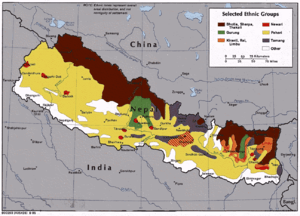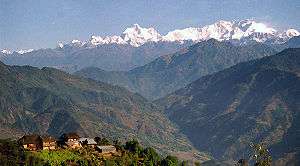Limbuwan
| Limbuwan (लिम्बुवन्) Limbu Yej Limbu Kingdom | ||
|---|---|---|
| State | ||
|
Typical Limbuwan villages. | ||
| ||
| Nickname(s): Yakthung Laaje | ||
 9 Districts advocated by Federal Limbuwan State Council in dark blue, historic Limbuwan maximum extent light blue, thick lines current international boundaries | ||
| Country |
| |
| Region | East Nepal | |
| Area | ||
| • Total | 6,316 sq mi (16,358 km2) | |
| Population (2011) | ||
| • Total | 3,574,770 | |
| • Density | 570/sq mi (220/km2) | |
| Time zone | Nepal Time (UTC+5:45) | |
Limbuwan is an area of the Himalaya historically made up of 10 Limbu kingdoms, all now part of Nepal. Limbuwan means "abode of the Limbus" or "Land of the Limbus". Limbus themselves call Limbuwan "Yakthung Laaje" or "the country of the Yakthungs" (see History of Limbuwan).
Today, Limbuwan comprises the districts of Taplejung, Panchthar, Ilam, Jhapa, Terhathum, Sankhuwasabha, Dhankuta, Sunsari and Morang.[1] Limbuwan is the land east of the Arun and Koshi Rivers and west of Kanchenjunga Mountain and the Mechi River. The seat of power in Kathmandu and western Nepalese refer to Limbuwan as the Pallo Kirant region or far Kirant, due to its distance from Kathmandu.
History

The Ten Kings of Limbus came together to formally declare all the ten kingdoms between the Arun River and Teesta River to be called "Yakthung Laaje".
The ten rulers, their kingdoms and their forts:
- Samlupi Samba Hang, King of Tambar and his capital Tambar Yiok.
- Sisiyen Shering Hang, King of Mewa and Maiwa kingdoms and his capital Meringden Yiok.
- Thoktokso Angbo Hang, King of Athraya and his capital Pomajong.
- Thindolung Khokya Hang, King of Yangwarok and his capital Hastapojong Yiok
- Yengaso Papo Hang, King of Panthar and his capital at Yashok and Pheden (Phe meaning "plain", den meaning "place").
- Shengsengum Phedap Hang, King of Phedap and his capital at Poklabung.
- Mung Tai Chi Emay Hang, King of Ilam and his capital at Phakphok.
- Soiyak Lado Hang, King of Bodhey (Choubise) and his capital at Shanguri Yiok.
- Tappeso Perung Hang, King of Thala and his capital at Thala Yiok.
- Taklung Khewa Hang, King of Chethar and his capital at Chamling Chimling Yiok.
Rise of King Mawrong
After a brief period, King Mawrong Hang came to prominence and took over Terai lands of Chethar, Bodhey, Panthar and Ilam (present day Jhapa, Morang Sunsari and Dhankuta). He named his Kingdom Morang after his name and rose to power. He subdued all the Ten Limbu Kings of Limbuwan and became their overlord. He died without any male heir and King Uba Hang took over as supreme ruler of Limbuwan in 849 AD- 865 AD. He made many religious and social reforms in Limbuwan. Uba Hang's worthy son Mabo Hang succeeded him in 865 AD and ruled till 880 AD. Uba hang kept on with the reforms his father had started. Uba Hang was succeeded by his son Muda Hang. Muda Hang was a weak ruler so the local chiefs started ruling their areas independently. Muda Hang was succeeded by his son Wedo Hang, by this time Limbuwan was in chaos and every principality was ruling independently and fighting with each other. Wedo hang was murdered and his son Chemjonghang succeeded.
Rise of King Sirijonga Haang
During this chaos and the waning phase of King Chemjong hang, King Sirijonga of Yangwarok kingdom rose to power. He subdued all the independent rulers and took over as the new supreme ruler of Limbuwan. He built two big forts in Phedap (present day Terhathum district) and Chainpur (present day Sankhuwasabha district). The remains of the structure still stand today. One of legacy was that he brought all the Limbus under the same writing system in Limbu script. He also brought feudal reform in Limbuwan and divided Limbuwan into new boundaries and districts.
Eventually after the establishment of Namgyal dynasty in Sikkim and under the Lho-Mehn-Tsong Tsum, a treaty between the Bhutia, Lepcha and Limbu people of the Sikkim area, Limbuwan lost the area between Kunchenjunga range (present day eastern border of Nepal) and Teesta River to the Bhutia Kings of Sikkim. Since then Limbuwan comprises all the area between Arun River and Koshi River in the west to Kunchenjunga Mountains and Mechi River in the east.
In the beginning of the 15th century, the descendants of King Sirijonga became weak and Limbuwan again fell into chaos and anarchy. At the time Lowland Limbuwan Kingdom of Morang was ruled by King Sangla Ing. Sangla Ing declared independence and became the first independent ruler of Morang in a century. His son Pungla Ing adopted Hinduism and changed his name into Aamar Raya Ing. He was succeeded by his descendents, who also bore Hindu names. Kirti Narayan Raya Ing, Aap Narayan Raya Ing, Jarai Narayan Raya Ing, Ding Narayan Raya Ing, and Bijay Narayan Raya Ing.
King Bijay Narayan Raya Sanlga Ing built a new town in the middle of Varatappa and Shangori fort and named it Bijaypur after him. He had no issue and died without an heir.
Bijaypur town was founded in 1584 AD and is currently located next to Dharan, Sunsari District. Bijaypur town remained the capital of Morang Kingdom and Limbuwan region until the Gorkha Limbuwan War in 1774 AD.
Morang Kingdom was the most powerful and influential of all the Kingdoms in Limbuwan region and was able to establish its hegemony among all the other Limbu rulers. But in 1609 AD Kirant King Lo hang Sen of Sen dynasty captured Morang and ruled it for seven generations.
King of Phedap Murray Hang was made the chief minister of Morong. He stayed in Bijaypur and the King of Morong made his post hereditary. Murray Hang was given a Hindu name and he became Bidya Chandra Raya . His descendents remained Chief Ministers of Morong until Buddhi Karna Raya Khebang . Buddhi Karna succeeded the last Sen King of Morang Kama Datta sen and sat in the throne of Bijaypur Palace in 1769 AD.
Annexation into Nepal
Meanwhile, the Gorkha King Prithivi Narayan Shah was on a campaign to conquer all the hill kingdoms into his Empire. He attacked Limbuwan in two fronts. After the Limbuwan Gorkha War 1771-1774 AD, the Limbu ministers of Morong, and Limbu rulers of the ten principalities came to an agreement with the King of Gorkha. With the Limbuwan Gorkha treaty of 1774, Limbuwan was annexed to Nepal.
Limbuwan was attacked several times by Sikkim after 1774 AD. Battle of Morong during the British Gurkha war took place in Morong. Limbuwan was divided into present day administrative districts in Panchayat era by King Mahendra. Taplejung, Therathum, Ilam, Panthar and Morang was named after their original names, whereas names of the other districts in Limbuwan were Hinduised.
Aboriginal inhabitants
The original inhabitants of Limbuwan are the Kirats, including the Limbus, Yakkha, Athpahariya, Yamphu, Meches, and Dhimal peoples. From the establishment of Limbuwan, these cultures have maintained their independent identity in Limbuwan coexisting peacefully with each other. Today, there is a movement for regional autonomy.
Immigration
The later arrivals are Newars, Bahuns and Chettris as missionaries of Hindu religion in the 1790s during the reign of King Prithivi Narayan Shah, Pratap Singh Shah and Rana Bahadur Shah. The Gurungs, Magars and Tamangs living in Limbuwan are also later arrivals who came as soldiers of Gorkha King during the Limbuwan Gorkha War in the 1780s. The madheshi settlers moved north and east from the Mithila region in the west, and thus also came during this time to cultivate the terai lands of Limbuwan.
Although Limbus, Dhimals,Yamphu, Lohorung, Aathprey, Koche and Yakkha are the aboriginal and native inhabitants of Limbuwan, there are a minority in their own territory today, due to mass immigration in eighteenth century sponsored by King of Nepal to cultivate the fertile lands of Limbuwan.
The Limbuwan Gorkha War was a series of battles fought between the King of Gorkhas and the rulers of various principalities of Limbuwan from 1771 to 1774 AD. The war came to an end in 1774 with the Limbuwan Gorkha treaty which recognised Limbu peoples' right to Kipat land in Limbuwan and full autonomy. History of Limbuwan covers the rest of the Limbuwan History.
After the conquest of Majh Kirant (Kirant Rai kingdoms) by the Gorkhas, they invaded Limbuwan on two fronts. One front was in Chainpur (present day Sankhuwasabha District) and the second front was in Bijaypur (present day Dharan, Sunsari District). Bijaypur was the capital of the Morang Kingdom of Limbuwan.
Mass migration of the Limbus
Following the end of Sikkim-Gorkha war at Limbuwan, the Gorkha officers started searching put people who had really sided with the Sikkimese party and started giving them death penalties. Seeing this, all the Limbus who had fought against the Gorkhas by siding with the Sikkimese King, assembled at the place called Ambe Pojoma and decided to leave Limbuwan forever. They were altogether 32000 in number and migrated in three groups. First group went to Sikkim and settles in Rung, Rhino and Magnesia villages, second group migrated to Bhutan and settled in Kuching, Tendu and Jumsa villages and third group migrated to Assam and settles in Beni, Kalchini and other Meche and Koch villages.
See also
References
- Chemjong, Iman Singh (2003). History and Culture of Kirat People (4th ed.). Kathmandu: Kirat Yakthung Chumlung. ISBN 99933-809-1-1.
External links
- Proposed ethnic states in 2010 incl. Limbuwan
- Welcome to Limbuwan
- Location
- Kirant Yakthung Chumlung
- Omniglot a guide to written language
- Nepal Ethnographic Museum
- Nepaldemocracy.com
- Ethnologue profiles: Limbu
- Iman Xin Chemjong


